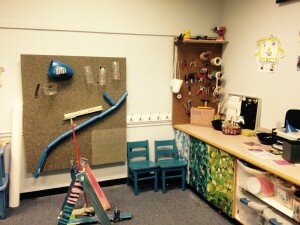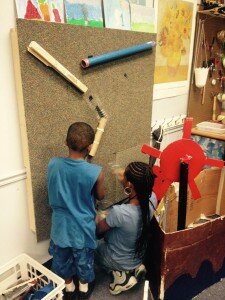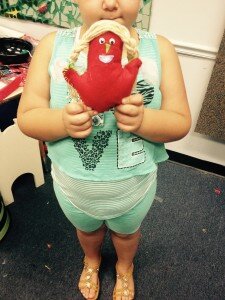
At the Kensington Library making a learning environment that is accessible, friendly, and interactive has been the most effective way of reaching the most “difficult” children. When school is over and children flock to the library, the last thing they want is to sit still and be told what to do. For some, art activities and creativity come naturally but for others beginning a project is just another task to do in a day full of instruction. I think it is important to provide these children with a space where learning is just part of the environment. On of our first
 additions to the Kensington’s Maker space was an interactive velcro wall where children design, build, and re-build a marble slide made from cardboard paper towel rolls and plastic bottles. Children often enter the Maker Space and start tinkering with the wall with out even thinking about it. A wall of tools has also helped to inspire projects. The visibility of the tools can be a great motivation for a child to learn to hammer, use an electric drill, or a needle and thread.
additions to the Kensington’s Maker space was an interactive velcro wall where children design, build, and re-build a marble slide made from cardboard paper towel rolls and plastic bottles. Children often enter the Maker Space and start tinkering with the wall with out even thinking about it. A wall of tools has also helped to inspire projects. The visibility of the tools can be a great motivation for a child to learn to hammer, use an electric drill, or a needle and thread.
 Over the summer we built a puppet theater from scrap material and children’s artwork. The theater has inspired many impromptu shows. It is a simple addition but because of its presence in the room, children are learning about narrative, character development, and collaboration. I have helped children fill out worksheets that have the same goal. For the kinesthetic learner these worksheets do little to help a child learn these concepts. Kinesthetic learners, learners that learn best by doing, are reported as having a much higher drop out rate in schools. This isn’t a surprise given how test driven most of our public schooling has become. Although it sometimes feels chaotic, providing a space with tools, supplies, and choice can be a big help to learners who are struggling to find a way to engage.
Over the summer we built a puppet theater from scrap material and children’s artwork. The theater has inspired many impromptu shows. It is a simple addition but because of its presence in the room, children are learning about narrative, character development, and collaboration. I have helped children fill out worksheets that have the same goal. For the kinesthetic learner these worksheets do little to help a child learn these concepts. Kinesthetic learners, learners that learn best by doing, are reported as having a much higher drop out rate in schools. This isn’t a surprise given how test driven most of our public schooling has become. Although it sometimes feels chaotic, providing a space with tools, supplies, and choice can be a big help to learners who are struggling to find a way to engage.

1 comment for “Learning Environments”